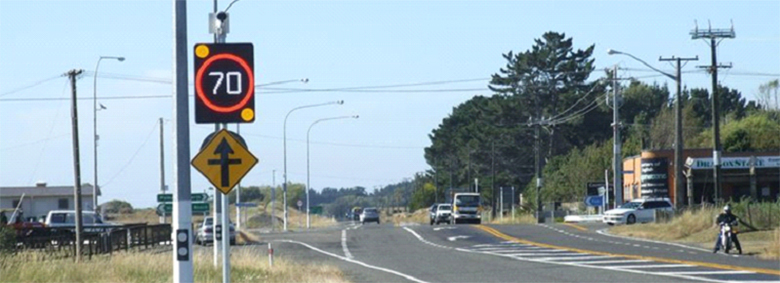Using technology for safer speeds.

Intersections require complex driving and decision-making. The fact that not all drivers get it right all of the time, and errors are made, is shown by the number of intersection crashes that occur.
Improving the safety of high risk intersections is a strategic priority under the government’s Safer Journeys road safety strategy and safer speeds is a Transport Agency priority. Humans are highly vulnerable to injury in high speed collision.
Under a Safe System, managing speeds through high-risk rural intersections is critical to improving survivability when vehicles crash. One potential solution comes in the form of an ‘Intelligent Transport System’ - Rural Intersection Activated Warning Signs (RIAWS).
The NZ Transport Agency is currently running a two-year RIAWS trial to address safe speeds at high-risk rural intersections. The RIAWS trial introduces speed limit signs at some intersections (for through traffic), which are activated by the presence of crossing/turning vehicles. So when the signs are activated, the through traffic reduces travel speed through the potential collision zone. When there are no crossing/turning vehicles at the intersection, the signs stay blank so the through vehicles are uninterrupted. This helps maintain the efficiency of the network.
The first sign in the trial (variable 70km/h) was installed at the Himitangi Cross Rds on the Foxton Straights in December 2012 following a period of speed surveys. The second was installed on the outskirts of Christchurch in March 2013, with four more (Invercargill, Palmerston North, and two in Northland) installed in October 2013. It is likely that up to four more sites will be fitted with this system within the two-year trial period.
This type of system has never been trialled before in New Zealand. In the past we would have had to rebuild the intersection into a safer form (which can be costly and impractical at many sites), and possibly permanently lower the speed limit which would be a lot less effective and efficient. In the future vehicle-to-vehicle collision avoidance systems may assist but this is still many years away.
Various evaluation criteria have been developed. One of the key ones is speed reduction. Speeds through the Himitangi intersection have been reduced by approximately 20km/h when the sign is operating, this reduces the likelihood of death and serious injury from 60% to around 25% should a collision occur. The Himitangi site has been operating for nearly one year and to our knowledge there have been no crashes at the site in that time.
An evaluation of drivers understanding and perception of the signs has also been completed. Overall, based on driver feedback, the RIAWS has generally been positively received. Most motorists understood what was required of them with 81% agreeing that RIAWS would make the intersection safer.
Although not suitable for every intersection, RIAWS has the potential for fairly widespread use. It costs between 5 and 10 percent of the price of a rural roundabout and so potentially 10 to 20 intersections could be treated with this type of system for the cost of one roundabout or major intersection upgrade.
The Transport Agency is committed to delivering safe speeds to save lives and reduce serious injuries. Developing innovative initiatives such as RIAWS is part of that commitment in the 2013-2016 period.